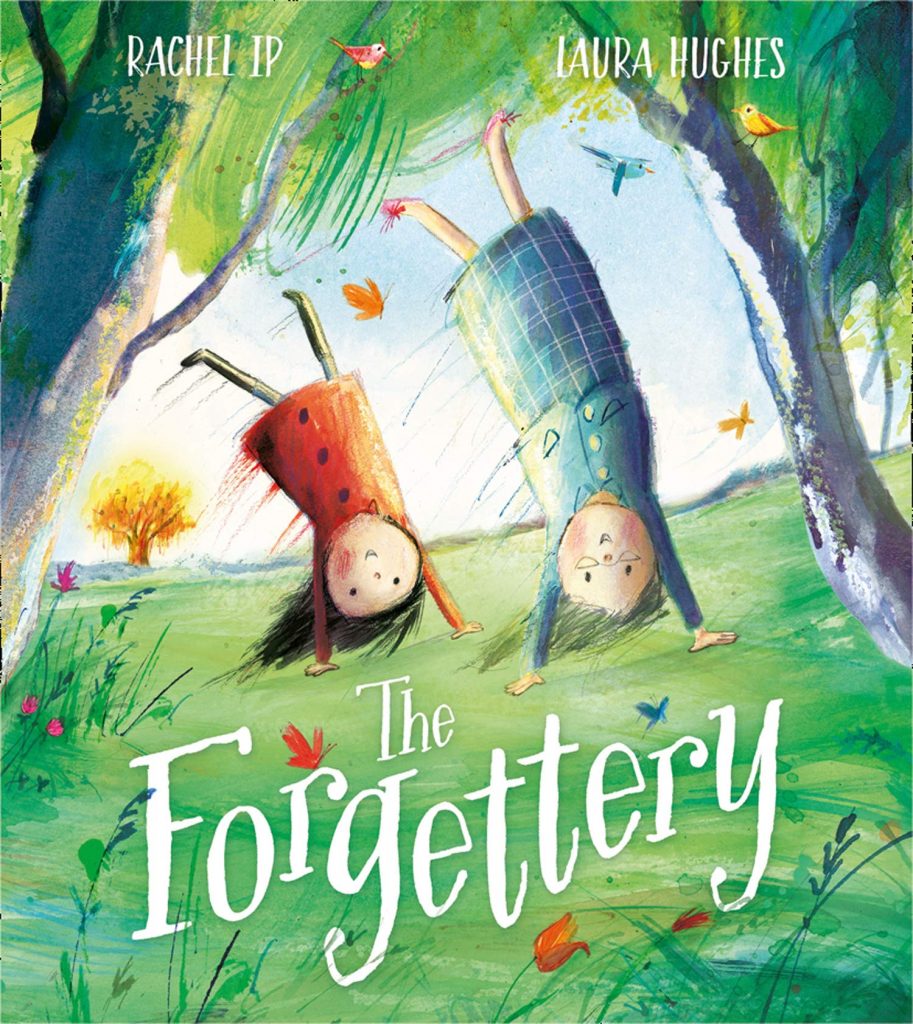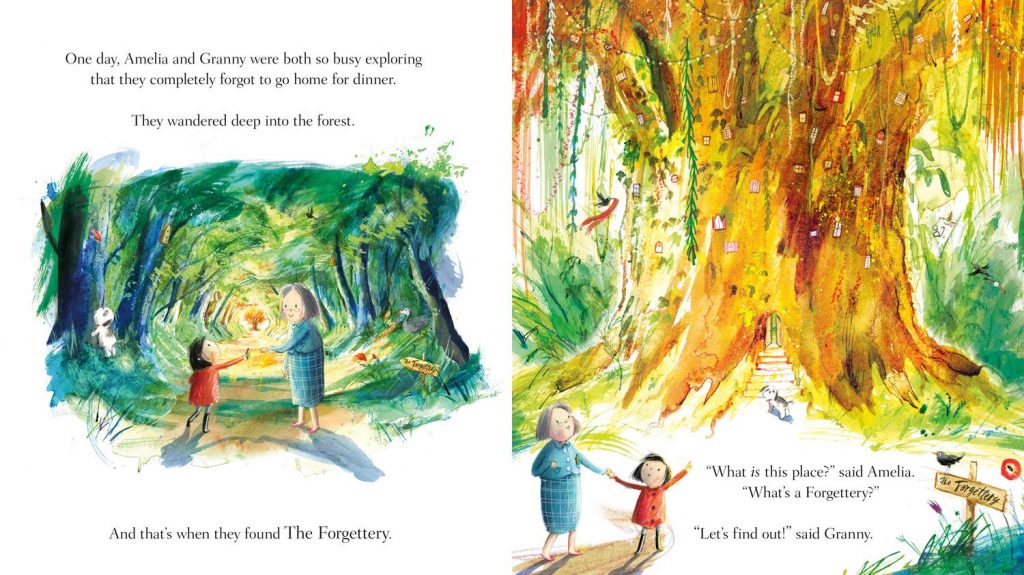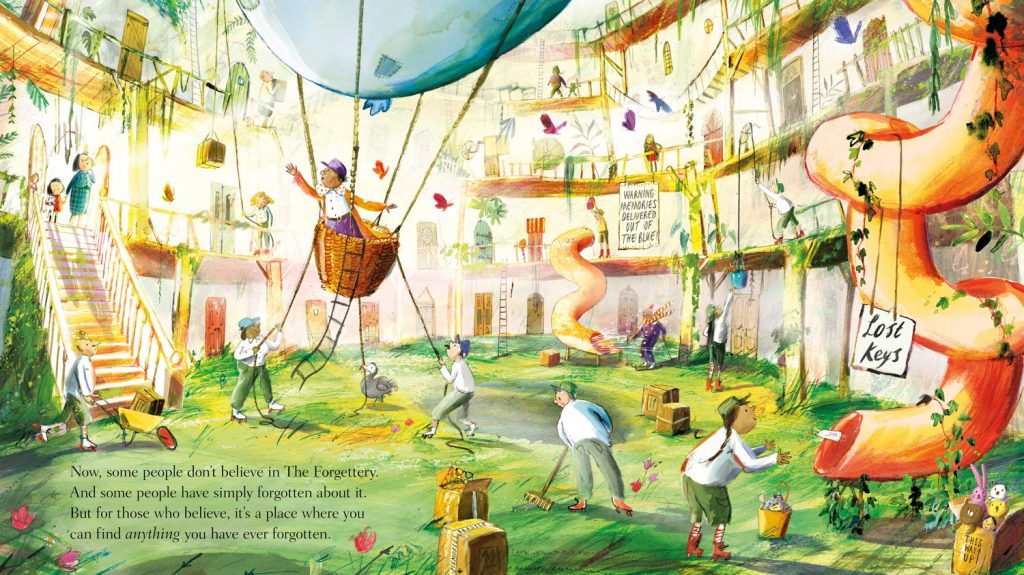Amelia’s granny forgets lots of things. Little things, like where she put her glasses, and big things like people and places. But everything anyone has ever forgotten is stored in The Forgettery, and there Amelia and her granny learn the power of making memories. Filled with warmth and gentle humour, The Forgettery is a beautifully written, sensitive look at dementia and memory loss. Today we talk to Rachel Ip and Laura Hughes about how they created The Forgettery!
Firstly, welcome to The Reading Realm! I wondered if we could start with you introducing yourselves?
Rachel: I’m a picture book author and my stories are often inspired by real-world events or experiences. After reading hundreds of picture books to my children (and some of those hundreds of times…), I started writing my own stories. I’ve spent the last 14 years in Hong Kong where I live with my family. The Forgettery is my second picture book.

Laura: Hello! I am a children’s illustrator, based in Hastings on the South Coast of England. I love picture books and have illustrated many titles for children including There’s a Pig Up My Nose, written by John Dougherty; Daddy’s Sandwich by Pip Jones and Hop Little Bunnies by Martha Mumford.

What is The Forgettery about?
Rachel: The Forgettery is an adventure story where Amelia and her Granny explore a fantastical world where memories can be re-discovered and revisited as well as newly made. It’s a story about remembering and treasuring our strongest and most precious memories and making new ones together, looking gently at memory loss and dementia.

What was your journey like to getting an agent and publisher?
Rachel: I started writing seriously in 2016 and joined the SCBWI (Society of Children’s Book Writers & Illustrators.) I started submitting and signed with Clare Wallace at Darley Anderson in 2017. My first book, The Last Garden was placed with Hodder Children’s Books soon after signing with Clare, and The Forgettery was placed with Farshore in 2018. The Forgettery was actually the first story I wrote so it will always be very special for me – I’m so happy to see it out in the world!
Laura: After graduating in 2005 from the BA Illustration course at Kingston I spent many years trying unsuccessfully to break into illustration while working a full-time job in retail. I eventually a managed to get a job as Artwork Manager at The Bright Agency and one of the best parts of the role involved finding and developing new illustrators. It was wonderful to be able to help others on their journey, and I developed a real understanding of what publishers look for in their artists. I used my evenings and weekends to develop my portfolio to the point where I could convince Bright to represent me too and my first picture book was with Meadowside Children’s books (who are sadly no longer trading). I’ve now been a full-time illustrator for nearly 10 years and I wouldn’t change it for the world!
What does a day in your life look like when you are working on your children’s books?
Rachel: I like to read some picture books or poetry to help switch into writing mode. If I’m working on new ideas, I might be doing research to find out more about the subject before diving into the writing. I write longhand in my notebook until I have got some structure to the story. Only then will I type it up and put it into a page plan and see how the pace is working. If I’m in the middle of a story, I always start by re-reading the full draft aloud, before revising. Life is quite chaotic at the moment, so I’m happy to snatch any writing time where I can!
Laura: My day starts around 9am with a cup of tea while I check emails, invoice clients and write social media posts. I can’t immerse myself in drawing if I know I have admin tasks to complete! I work on one book at a time, so my afternoons will be spent either creating artwork for roughs, or completing final artwork. As deadlines approach I listen to a lot of music: punk, techno, metal – anything with a fast beat to help me get things done quickly, otherwise I like to listen to Radio 4 especially Women’s Hour.
What is the editing process like for you? What does it involve? What did you have to edit out of this book to make it work?
Rachel: I worked closely with my brilliant editor, Melissa Fairley at Farshore, and we explored a couple of different options for the ending before agreeing the final wording. There were a couple of scenes I re-wrote or shortened once we saw Laura’s incredible artwork. One being the scene with the hot air-balloon, which is so beautiful, and the original wording didn’t quite work. This story went to print towards the end of last year. Originally, Amelia’s Forgettery had a sentence about all the times she had forgotten to wash her hands. We decided to take it out because children have been washing their hands so carefully since the pandemic started and it felt out of place in the current context.
In the story, how do Amelia and Granny find the Forgettery?
Laura: Rachel suggested that Granny and Amelia could enter The Forgettery through a Holloway, which is a path that has been worn down by people walking the same route over hundreds of years. Holloways have an inherent connection to time and memory and so it made sense that the path to the Forgettery should be worn down over a great many years by all the people coming to find their lost memories!

How did you decide on the style of the tree when you were drawing the Forgettery?
Laura: I wanted the Forgettery to be contained inside a large tree, rather than a building, and so I took inspiration from the amazing Banyan trees and their aerial prop roots as they look really magical and wise! The entrance to The Forgettery is a plain (almost forgettable), small door that opens into a vast room. I really enjoyed playing around with scale and the idea that such a gigantic structure could be found within a tree, albeit a magical one! Inside the Forgettery are smaller rooms that contain each person’s individual Forgettery room, each with a distinct door. I even included the very famous front door of No. 10 Downing Street, as I’m certain the Prime Minster forgets things too! Amelia is very young compared to Granny so I placed her room near the top of The Forgettery amongst the thinner branches, just like the newest shoots of a tree which are found at the tips of the plant.
What was the hardest thing about creating the illustrations in the story?
Laura: One of the hardest things for me when creating the illustrations was to figure out how the forgotten things could be delivered to The Forgettery. After much deliberation I decided to have birds carrying the lost toys, glasses and watches to The Forgettery – in keeping with the natural theme. I also included a couple of extinct animals as a Forgettery might be the kind of place to find them.
How did you decide what to include inside Granny and Amelia’s forgetteries?
Laura: Granny would have possibly been born in the early 1950’s, so she was part of a generation that experienced huge changes in their lifetime. Granny’s Forgettery includes some iconic shoes and outfits from the 1960’s and 1970’s, as well as some old technology that adults may have forgotten! The butterfly memory of Granny on a motorbike in her Forgettery room was based on one of my own Nana’s memories. In the 50’s she travelled all the way to Cornwall and back with my Granddad on an old motorbike. It was only when they pulled into the driveway at home that the motorbike burst into flames! My Nana sadly passed away in January 2021 having lived with Parkinson’s Dementia for several years. My dedication is for her.

What’s the best thing about being a children’s author and illustrator?
Rachel: It’s all very new to me, but it’s been lovely to see children’s reactions at the few live events I’ve done so far! The response to The Forgettery has been very moving. People have shared incredible photos of memory books they have made to support their loved ones living with dementia, and we’ve seen brilliant photos of Grannies and Great-Grannies who are over 100 years old!
Laura: The best thing about creating picture books is the connection we share with the reader. Knowing that your book has helped a child to make sense of the world, started a challenging conversation, or has simply been a shared moment between parent and child, is such an incredible feeling. And the fact that I get to do something I love every day – I feel incredibly grateful for that.
How would you envisage teachers using The Forgettery in their classrooms? What age group is it aimed at? Do any activities or ideas spring to mind?
Rachel: Nearly one in three young people know someone living with dementia, and we hope The Forgettery can be a bridge into conversations around this challenging topic. We’re preparing some resources for schools and there are some craft activities based on the book in this video we prepared to celebrate the publication of the book. I’d love to see children exploring creative writing activities and art based on the story.
Can you recommend a book you’ve enjoyed recently and one you’re looking forward to?
Rachel: There are so many! I really loved Where the Sea Meets the Sky by Peter Bently and Riko Sekiguchi. I’m looking forward to Julian at the Wedding by Jessica Love.
Laura: Maya and Cat by Caroline Magerl is my current favourite picture book. Both the words and the illustrations work beautifully together to create a gorgeously inky world that I want to immerse myself in…plus it contains cats! I’ve just ordered Dreams for our Daughters by Ruth Doyle and Ashling Lindsay so I’m looking forward to enjoying that too.
Finally, can you describe The Forgettery in three words?
Treasuring magical memories.

